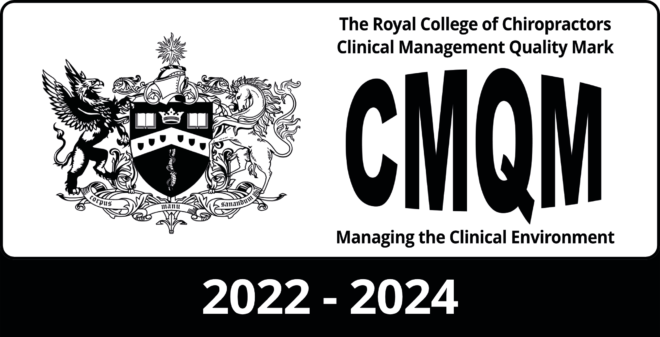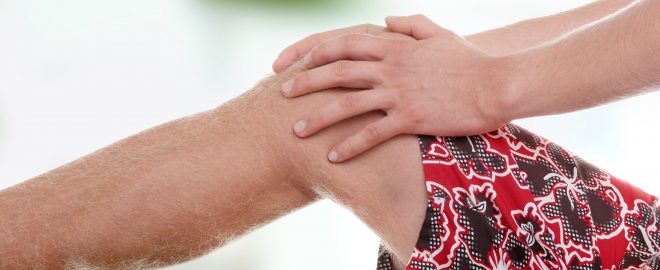
Clinic News
Happy New year to you and your family. We hope you managed to have a special Christmas and meet up with friends and family. Let us hope 2022 is a year where we can move forward and achieve bigger and better things.
We certainly left 2021 with a big bang achieving our 11th consecutive year for the Clinic Management Quality Mark (CMQM) and Alex finally managed to take her practical cranial fascial dynamics exam in Oxford
The CMQM is awarded to chiropractic clinics that demonstrate excellence in terms of operating within a well-structured and managed clinical environment. Applicants demonstrate excellence in a range of areas including clinical audit, incident reporting and patient satisfaction. The award will be formally announced at the Royal College of Chiropractors’ virtual AGM in January 2022 by the President and Chair of the Royal College’s Health Policy Unit.
Alex said “The award of the Clinical Management Quality Mark recognises this clinic’s commitment to operating in a professionally managed environment. The aim of our clinic team is to continually improve and the award encourages us that we are achieving this”
It is a team effort to deliver this application and it starts with you, our patients participating in surveys and giving feedback through the years - so we are grateful for your continued support.
With the clinic being closed for extended periods over the holidays all team members have had a good rest, recharged and are eagerly awaiting your return for your new year, new you start. Get in touch if it's been a while since your last check-up, we'd love to level you up and keep you moving for 2022.
Check out some essential advice below from getting that spine moving to letting it rest well at night.

Tips to Improve Spine Health
Spine health is all about mindfulness and constant care. Maintaining a healthy spine, will make everything you do in life a bit easier. Here are some tips on how to keep your spine healthy.
If you can, stretch every single day. Always warm up for 3-5 minutes before you stretch fully. Remember, never stretch cold muscles. Usually after a run or workout you are able to stretch more intensely.
Over time, our muscles and tendons become used to the motions we most regularly perform, tightening up if they are not continually stretched out. The more flexible they remain, the less chance you’ll suffer from a pulled muscle.
Along with staying limber and flexible, you’ll need to make sure your back muscles are strong enough to help you maintain proper form for the entirety of your workouts. Even a few moments of slouching can lead to a pulled back or slipped disc which is not good for spine health.
Try a few weight-lifting and core strengthening exercises at least a few times a week.
Working the body is great but make sure that rest days are taken seriously. Whether you’re practising for marathons or just getting your thirty minutes of activity in, many people forget just how important rest days are.
By not working out on certain days, the body is able to repair damage while simultaneously making your muscles stronger. Too much exercise means this healing doesn’t happen. Make sure you have at least one day a week set aside for rest and repair.
Good spinal health is directly related to a good diet and staying hydrated. Providing your body with necessary nutrients, vegetables, fruits, whole grains, and nuts are required. With these, the body can better heal areas that are injured or are showing signs of injury.
Be sure to practice these tips for a healthy spine.

Sleep Well
80% of UK adults will experience back pain at some point in their lives – so what is causing it? With this rate being so high, it is important to highlight some of the everyday activities, which, if conducted wrongly, can lead to back pain. One of the main ones to focus on is sleep – everyone does it, so it is important to know how to do it properly!
Below are some of the sleep positions that can cause you pain:
- When sleeping on your front, your head is turned slightly to the side as not to suffocate completely. As a result, this can cause a large amount of strain on the neck, which could lead to pain throughout the day. This position also means that your spine is completely unsupported, which could lead to extreme back pain.
- When sleeping on your left side with your arms completely out, you are essentially restricting blood flow and putting a large amount of pressure on your nerves; which can result in soreness in the shoulders and arms. Like sleeping on your front, the spine is completely unsupported in this position and therefore could lead to both upper and lower back pain.
- Whilst sleeping in the foetal position is a favourite amongst many, it is actually one of the worst sleep positions because of its complete lack of support for the neck and spine. As a result of the curvature of the spine in this position, neck and back pain is extremely common.
These positions can ease back pain:
- By sleeping flat on your back, your spine is completely supported, which will help ease the pain caused to the neck and back. By keeping your arms by your side, you are reducing strain on the shoulders as well.
- If you continue to feel soreness in your back after sleeping on your back, try the exact same position but with a small pillow underneath your knees. This helps your body to maintain a healthy curve in the lower back.
- If you want to sleep on your side, you absolutely can by just making sure your arms are kept down by your side instead of being stretched outwards. This actually supports the spine in the position of its natural curve.

Can You Be Too Supple?
Some people are very flexible, while others aim to improve their flexibility through yoga classes and stretching exercises. However, have you ever considered that there is such as thing as too supple?
Hypermobility means that you can move some or all of your joints in a way that most people cannot, without pain. Joint hypermobility is what some people refer to as having “loose joints” or being “double-jointed”. The joints most commonly affected are the knees, shoulders, elbows, wrists, and fingers.
Many people with hypermobility do not experience any problems. In fact, people such as dancers, gymnasts and musicians can actually benefit from the increased flexibility. However, there are times that you should seek medical advice and treatment for hypermobility.
People should seek treatment if they experience:
- Pain in the loose joint during or after movement
- Sudden changes in the appearance of the joint
- Changes in mobility, specifically in the joints
- Changes in the functioning of your arms and legs
Often additional symptoms are minimal and may only become apparent after minor trauma.
In addition to genetic factors, hypermobility can be caused by weak muscles supporting the joint.
Other causes of hypermobile joints can include trauma, developmental issues, and hormonal factors.
During pregnancy the female body increases production of the hormone oestrogen and produces the hormone relaxin. The function of these hormones is to increase ligament laxity enabling the female pelvis to accommodate the growing foetus and helps to open the birth canal during labour. It can also cause hypermobility of the lumbar spine and of the sacroiliac joints of the pelvis.
Treatment for hypermobility syndrome can include strengthening exercises that will stabilise the joint. It is also useful for people to develop an awareness of what the normal range of motion is for each joint in order to avoid hyperextension. However, those with related medical conditions or who are pregnant should seek the advise of their chiropractor to establish a safe exercise plan.

Stress-free Exercise Tips
It is estimated that 80 million working days are lost in the UK each year due to stress.
Stress can be caused by more than just emotional challenges. It can also have a physical cause, for example, infections, allergies, extreme temperatures, environmental pollutants and even exercise can put pressure on the body.
Many people think of exercise as a stress reliever, however, our frame is designed for gentle exercise on a daily basis yet most people sit down all day. As a result, the muscles become weak, causing joint restrictions, back and other problems with the bones and joints.
When we do exercise, usually snatched during an hour from a busy schedule, it’s followed by days of inactivity. This approach may well increase the risk of back and joint problems.
Stress is quickly manifested in the muscles and bones and can lead to joint dysfunction, especially in the spine. This can also cause persistent headaches, migraine, neck and back pain.
Stress – Free Exercise Tips
- Always do warm–up exercises to avoid straining muscles
- Exercise for at least 30 minutes at least three times a week
- Wear the correct trainers to soften impact, particularly when jogging or running on hard surfaces
- Try and monitor your heart rate when exercising – it should rise to about 80% of its maximum; it is easy to calculate your maximum heart rate by deducting your age from 220, therefore, if you are 40 years old, your maximum heart rate should be 180 beats per minute, 60-80% of this is about 110 to 145 beats per minute
- Warm–down your muscles by doing gentle stretching moves
We treat all conditions that affect any muscle or joint in your body, from your head to your little toe! One of the most common complaints that we treat is back pain and Chiropractic is recommended by the government authority, the National Institute for Clinical Excellence (NICE) for acute and chronic back pain. Some of the other conditions that we treat are neck and headache, shoulder pain, leg and hip pain, knee and foot pain, sciatica and arthritis. Our registered Chiropractors all have at least five years of training. Treatment costs can be covered through most health insurers. If you are in any doubt, we are always very happy to talk with you on the phone to see if your condition will respond well to Chiropractic treatment. Call the clinic now to arrange an appointment time that works for you. 0115 9225085 If you would like to opt-out of receiving these newsletters please follow the unsubscribe link below, email alex@beestonchiropractic.co.uk or let us know at your next appointment.





